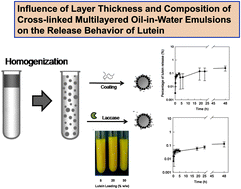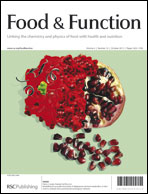Influence of layer thickness and composition of cross-linked multilayered oil-in-water emulsions on the release behavior of lutein
Abstract
Multilayering and enzymatic cross-linking of emulsions may cause alterations in the release behavior of encapsulated core material due to changes in thickness, porosity and permeability of the membrane. An interfacial engineering technology based on the layer-by-layer electrostatic deposition of oppositively charged biopolymers onto the surfaces of emulsion droplets in combination with an enzymatic treatment was used to generate emulsions with different droplet interfaces to test this hypothesis. Release behavior of primary, secondary (coated) and laccase-treated secondary emulsions carrying lutein, an oxygenated carotenoid, was characterized and studied. Fish gelatin (FG), whey protein isolate (WPI) and dodecyltrimethylammonium bromide (DTAB) were used as primary emulsifiers under acidic conditions (pH 3.5) to facilitate the adsorption of a negatively charged biopolymer (sugar beet pectin). Laccase was added to promote cross-linking of adsorbed beet pectin. The release of lutein-loaded emulsions was investigated and quantified by UV-Vis spectrophotometry. Primary WPI-stabilized emulsions showed a five times higher release of lutein after 48 h than secondary emulsions (pH 3.5). Primary DTAB-stabilized emulsions released 7.2% of encapsulated lutein within the observation period, whereas beet pectin-DTAB-coated emulsions released only 0.13% of lutein. Cross-linking of adsorbed pectin did not significantly decrease release of lutein in comparison to non-cross-linked secondary emulsions. Additionally, release of lutein was also affected by changes in the pH of the surrounding medium. Results suggest that modulating the interfacial properties of oil-in-water emulsion by biopolymer deposition and/or cross-linking may be a useful approach to generate food-grade delivery systems that have specific release-over-time profiles of incorporated active ingredients.


 Please wait while we load your content...
Please wait while we load your content...